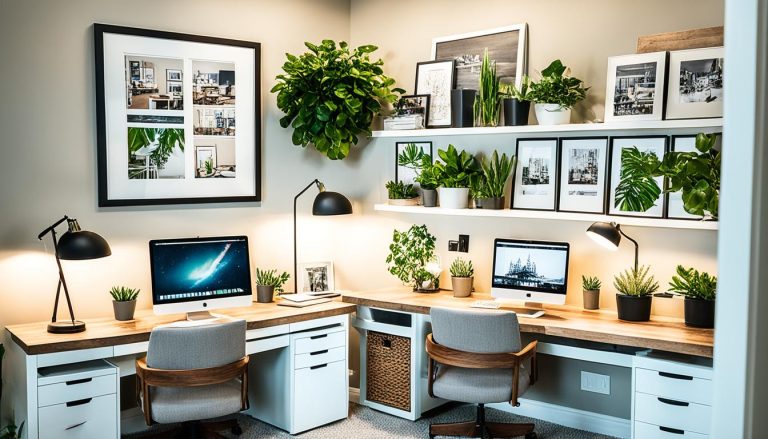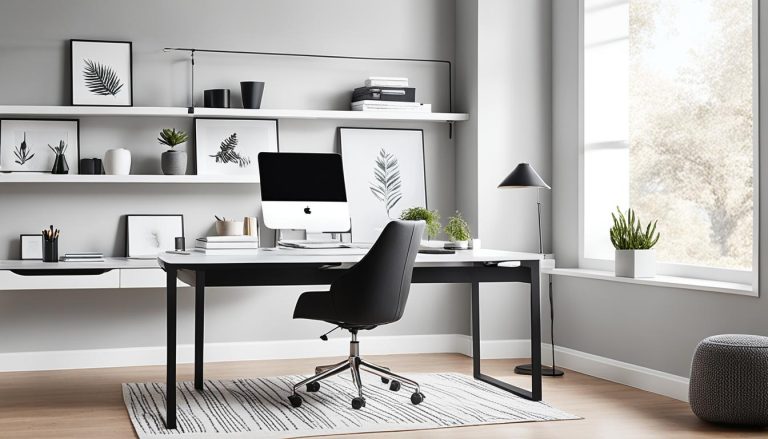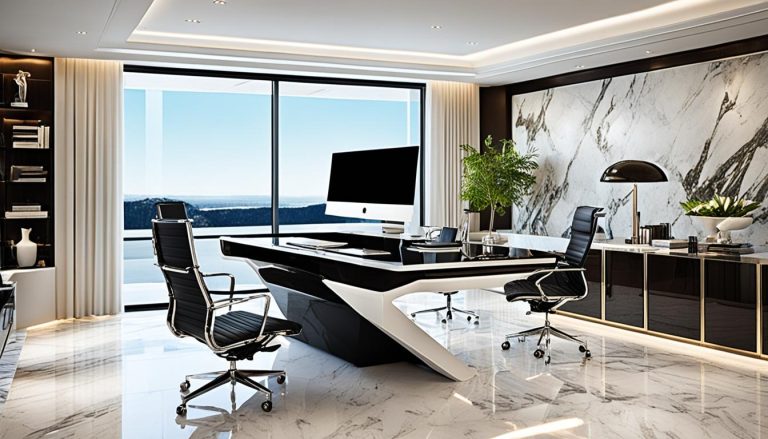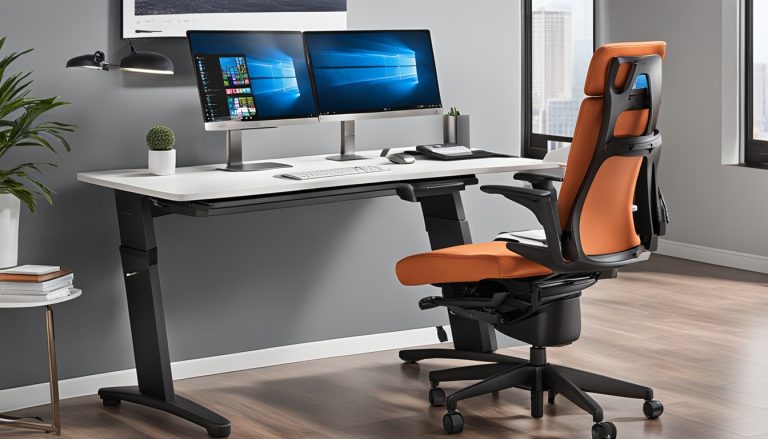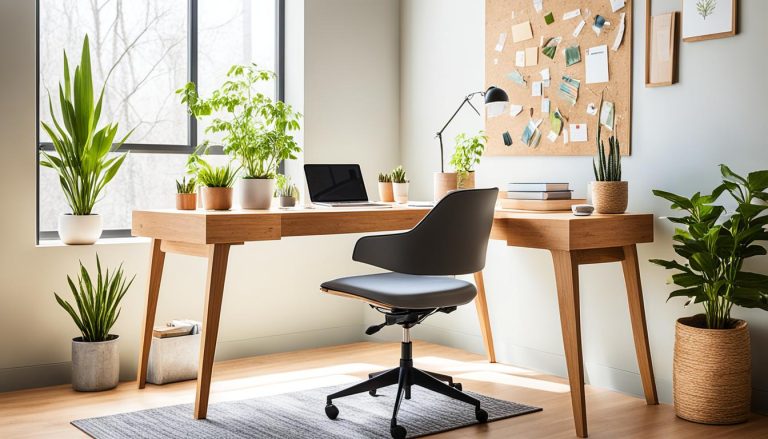Home Office Layouts for Different Work Styles: Boost Productivity and Comfort
houseremodelingnews.com may earn a commission if you purchase a product through one of our links
“The office of the future is not a place, it’s a space between technology and people.” – Cecilia Tham, Founder of MOB
Today, your home office layout is key to your productivity. With 40% of Americans working from home full-time and 35% choosing a mix, it’s vital to have a space that suits your work style.
We’ve found 65 home office ideas to inspire you. Whether it’s a minimalist setup or a vintage-inspired space, your office should show your style and help you work better.
Are you looking to improve your remote work setup? Let’s see how different layouts can make your work more productive and comfortable. Every day at work can become easier.
Understanding Work Styles and Their Impact on Home Office Design
Your work style is key to designing your perfect home office. Knowing how you approach tasks helps you make an ergonomic space. This space will increase your productivity and comfort.
The Four Main Working Styles
There are four main work styles:
- Pioneers (35-40%): Innovative and adaptable
- Drivers (25-35%): Goal-oriented and efficient
- Guardians (12-22%): Detail-focused and organized
- Integrators (15-19%): Collaborative and relationship-oriented
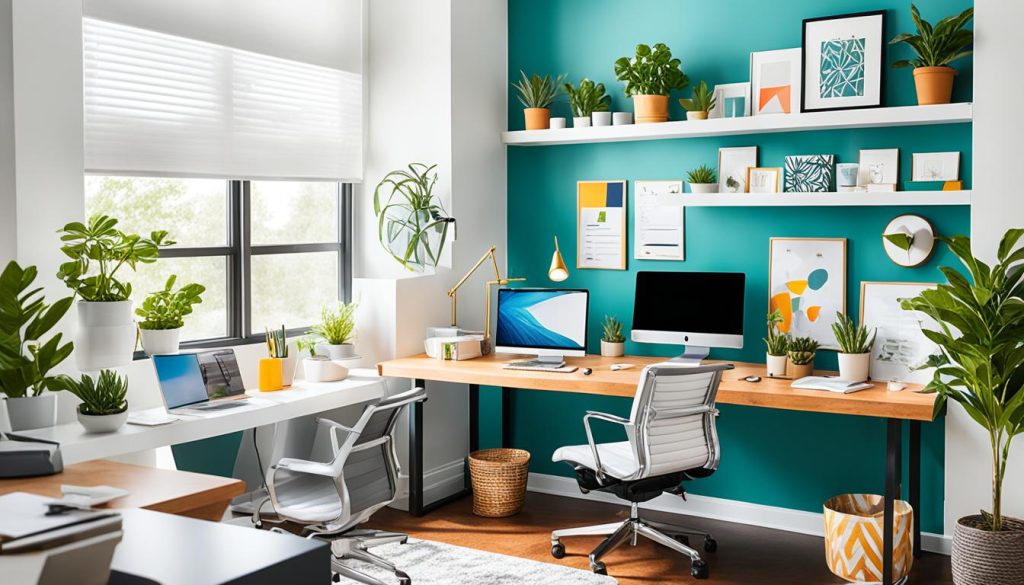
How Work Styles Influence Office Layout Preferences
Your work style affects your ideal office setup. For instance, Pioneers might like open, lively areas. Guardians might choose tidy, structured spaces. A Clutch survey found 52% of employees prefer private offices, showing the need for personalized spaces.
The Importance of Tailoring Your Workspace
Customizing your home office to fit your work style boosts productivity. Research shows 65% believe matching their office with their ideal space would help them work better. By thinking about layout, colors, and furniture, you can make a space that supports your work style.
“The right office design can make all the difference in how we work and feel throughout the day.”
Your home office should mirror your professional identity and work habits. Whether you need a space for teamwork or quiet focus, making it fit your needs can improve your comfort, satisfaction, and productivity.
Pioneers: Creating Dynamic Spaces for Go-Getters
Pioneers love dynamic office spaces that spark their creativity and energy. They need workspaces that match their quick thinking and love for new challenges.
For Pioneers, flexible workstations are key. They should allow easy movement and quick tech access. Height-adjustable desks and ergonomic chairs are great for these active minds that can’t sit still.
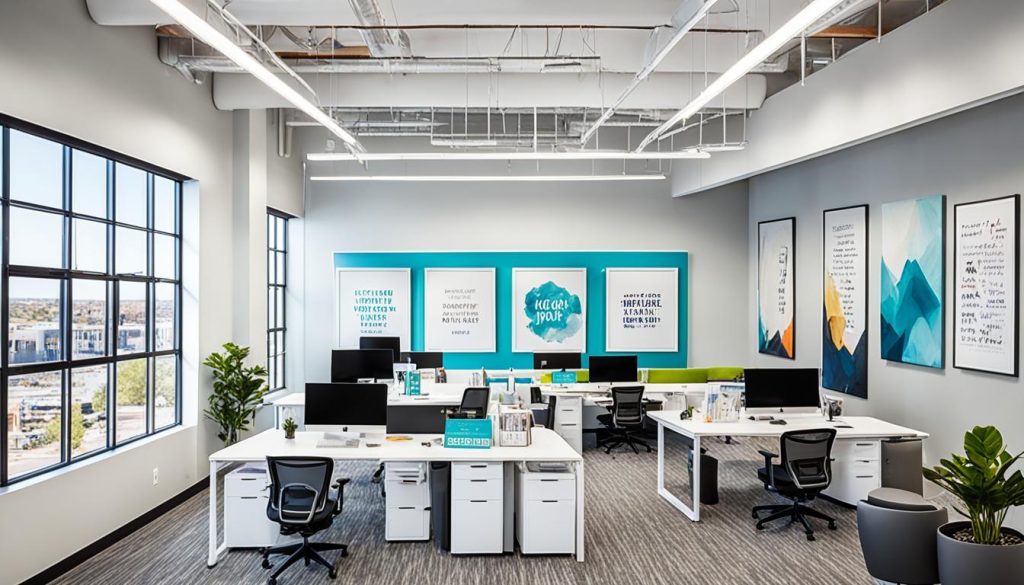
Open workspaces are perfect for Pioneers. They encourage teamwork and sharing ideas on the spot. But, they also need semi-private spots for deep focus when needed. This mix supports their social and independent work styles.
“Meeting space flexibility and access to interactive technology are crucial for the future of workspaces,” according to 66% of respondents in a recent IMEX America study.
When designing for Pioneers, remember these important points:
- Simple and modern designs
- Easy access to computers and communication tools
- Spaces that allow freedom of movement
- Areas that facilitate quick decision-making
Creating dynamic office spaces for Pioneers can greatly improve their productivity and happiness. These energetic workers love change and innovation. So, don’t hesitate to try new layouts to find what works best.
Drivers: Designing Workspaces for Goal-Oriented Professionals
Creating a goal-oriented workspace for drivers means mixing traditional office furniture with a team-friendly design. These professionals love challenges and deadlines. It’s important to make an environment that helps them reach their goals.
Traditional Office Furniture with a Modern Twist
Drivers like a structured setting. Use classic items like a strong desk and an ergonomic chair. Add a modern feel with desks that adjust in height or sleek storage. This mix of old and new meets their love for tradition and boosts productivity.
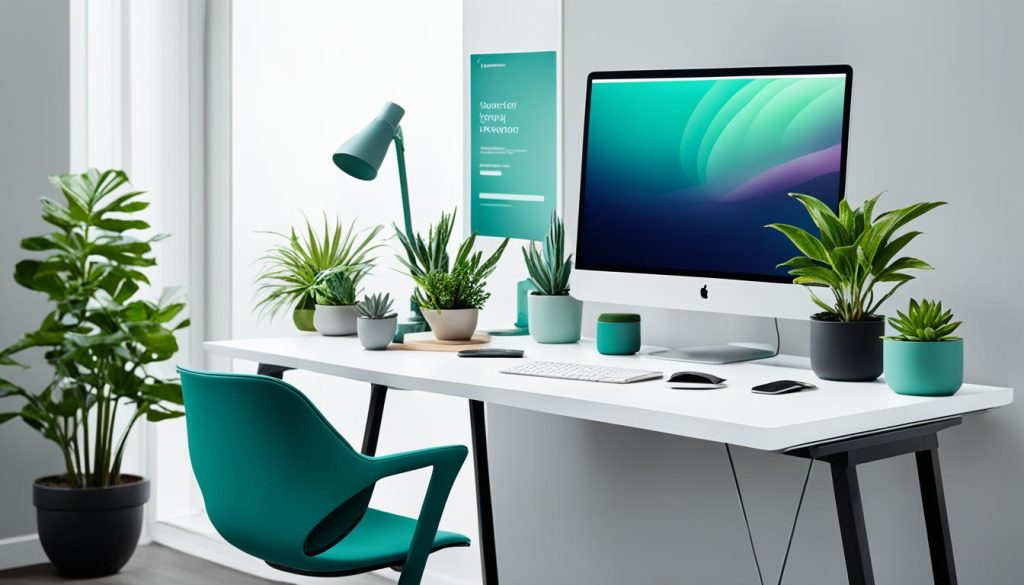
Incorporating Team-Friendly Elements
Even though drivers focus on their goals, they also value teamwork. Add a small meeting spot with comfy seats and a whiteboard for ideas. This design encourages teamwork without losing individual work areas.
Balancing Privacy and Collaboration
Drivers need both private and open areas. Make a special work spot in a bigger room to help them stay focused. Use dividers or plants to separate areas but keep them connected. This setup makes it easy to switch between working alone and working with a team.
A well-designed workspace for drivers increases productivity. By combining traditional office furniture with team-friendly features, you’ll make a space where goal-oriented professionals can do their best.
“A comprehensive office layout typically includes modular spaces, ergonomic furniture, natural light, storage solutions, live plants, noise control, technology for collaboration, and tools for visitor management.”
Guardians: Crafting Stable and Organized Environments
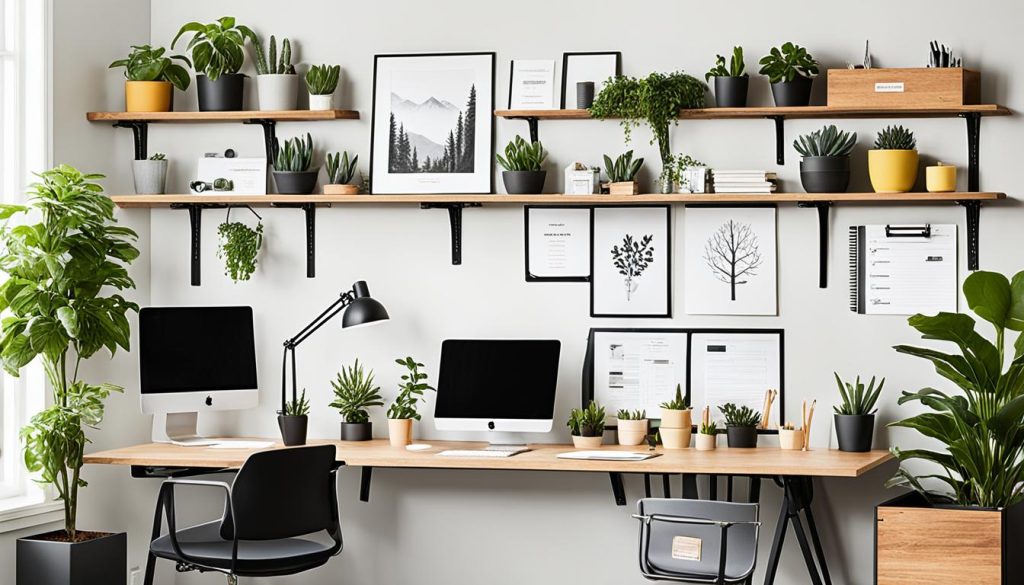
Guardians do well in a stable work setting. They like things to be orderly and predictable every day. To make a great space for them, focus on making an organized workspace. This helps with efficiency and peace of mind.
Begin by adding smart storage solutions. Put in shelving units and filing cabinets to keep papers and supplies tidy. This keeps their desk clear of clutter, helping them stay focused on their tasks.
Here are some tips to boost productivity:
- Use drawer dividers to sort small items
- Label folders and containers for easy access
- Designate specific areas for different tasks
- Invest in cable management systems to reduce visual clutter
Privacy is key for guardians. Create a personal space with partial walls or dividers in the home office. This setup lets them focus without distractions while still feeling connected to the area.
A well-organized workspace is more than just clean. It’s about making a place that supports their need for structure and routine. By using these tips, you’ll make a home office that helps guardians do their best work.
Integrators: Fostering Collaborative and Social Workspaces
Integrators do well in offices that encourage teamwork and building relationships. They are great at bringing people together. This makes collaborative workspaces key for their success and happiness.
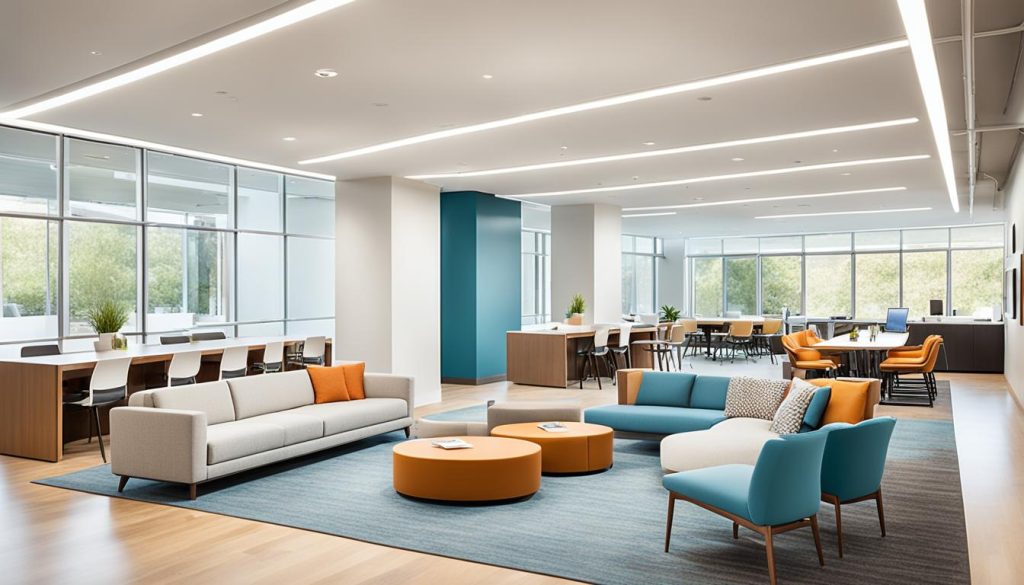
Open and Comfortable Seating Arrangements
For integrators, starting with open, comfy seating is key. Using modular sofas and soft chairs helps teams gather and share ideas easily. These setups can change to fit different group sizes and activities.
Creating Spaces for Team Interactions
Having special spots for teamwork is important. These areas have writable surfaces, digital screens, and wireless sharing tools for workshops and brainstorming. They help teams be more creative and talk better with each other.
- Modular furniture for flexibility
- Writable surfaces for brainstorming
- Technology integration for seamless collaboration
Balancing Social Areas with Quiet Zones
Integrators love being social, but they also need quiet spots. Adding areas for quiet work lets them move between team tasks and solo work easily. This mix helps everyone work better and suits different work styles.
“Successful collaborative work environments encourage informal encounters, respect different work patterns, and offer flexibility to employees.”
With these design ideas, you can make a space that boosts teamwork, communication, and productivity for integrators and their teams.
Home Office Layouts for Different Work Styles

Creating a home office that fits your work style is key to success. Today, 65% of workers do some work from home, making custom workspaces vital. Let’s look at some design ideas for different work preferences.
For those who love teamwork, an open layout is great. It’s used by 70% of companies and boosts interaction and flexibility. Use two desks facing each other for team projects or handling multiple tasks.
If you prefer quiet for work, go for a traditional setup with your desk by a window or wall. Add etagere shelves for storage and style. This layout fits well in rooms about 11’3″ wide by 11’10” long.
- L-shaped desks offer both workspace and storage
- Have a reading nook for extra versatility
- Set up a Zoom-friendly backdrop for online meetings
For those who move around a lot, a hybrid layout might be best. It’s chosen by 50% of companies for its flexibility. Mix different office styles to suit your needs. Add a standing desk and a cozy seating area for changing tasks during the day.
A well-designed home office isn’t just about looks; it’s about making a space that boosts your productivity and shows your work style.
Your home office should mirror you. Whether you like a simple setup or a unique space, aim to create an area that motivates and inspires you to excel.
Designing for the Messy Types: Embracing Organized Chaos
Love a creative space that’s a bit messy? You’re in good company. Many creative people find their spark in a cluttered desk. It’s all about finding productivity in what seems chaotic to others.
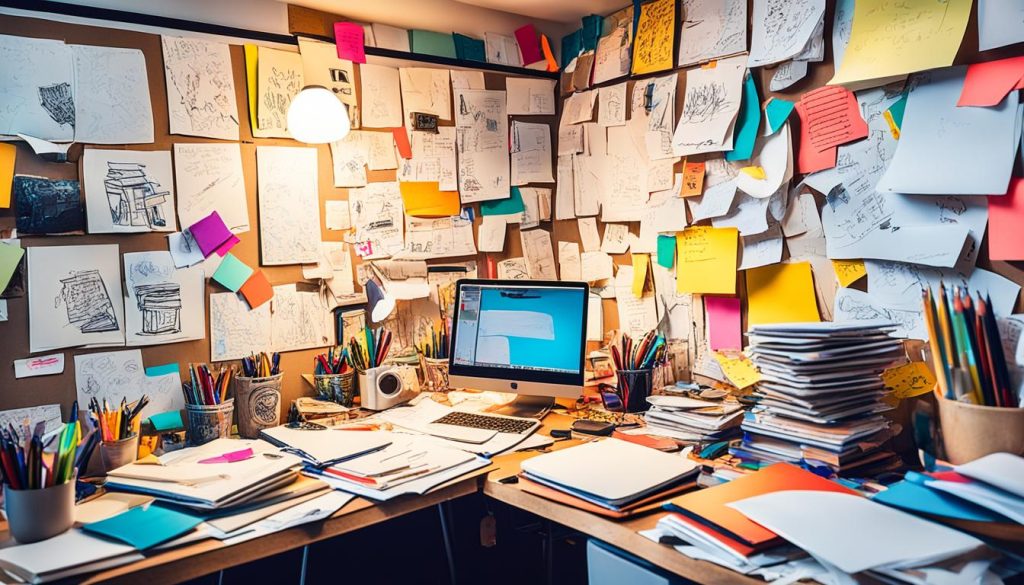
Think about getting a big desk for your needs. It lets you spread out papers, supplies, and snacks. The Quartet Desktop Glass Monitor Riser ($75 on Amazon) adds vertical storage. This keeps things tidy without limiting your creativity.
Being productive with a messy desk means having everything you need close by. Use Stackable White Paper Trays ($39 on Amazon) to organize your papers. For small items, the Everything Organizer Drawer Organizer ($5 at The Container Store) keeps things in sight but tidy.
“One person’s mess is another person’s masterpiece.”
Your workspace should mirror your creative process. The Modular Desk Organizer ($45 on Etsy) is flexible and changes as you do. And for those pesky cables, Bluelounge Mini CableDrops ($12 at The Container Store) keeps them from getting lost.
Embrace your unique way of working. Your messy desk might just spark your most brilliant ideas!
Catering to the Neat and Organized: Maximizing Efficiency
For those who love tidy spaces, a well-organized home office is crucial for staying productive. Let’s look at how to make a space that keeps things tidy and boosts focus and efficiency.
Incorporating Ample Storage Solutions
Having enough storage is key to a clutter-free desk. Ladder desks with built-in shelves are stylish and practical. Add open shelving above your desk for your favorite office items. Use colorful document boxes and large wicker bins for extra storage on the floor.
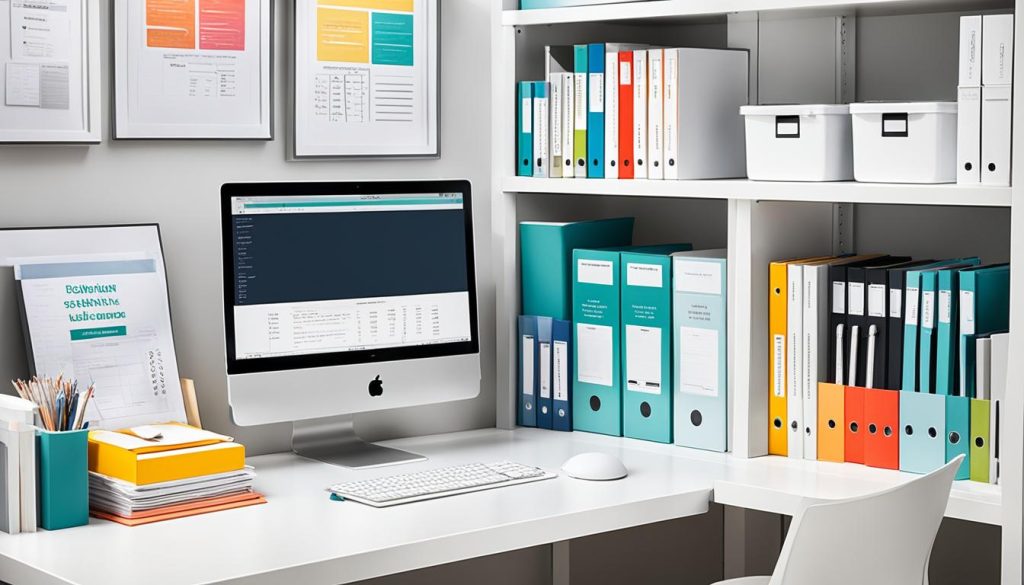
Implementing Clean and Minimalist Design Elements
Minimalist decor helps create a calm, focused space. Choose furniture with clean lines. Symmetry in your layout makes your space look cleaner and more organized. Use a color-coordinated system, organizing supplies by color to mix function with style.
Utilizing Color Schemes for Focus and Organization
Colors are important for keeping things organized. Use bins and binders in matching colors to help you stay productive. Paint a wall with chalk paint and divide it for a calendar. This adds both function and style to your space.
“When there’s symmetry, you’ll perceive your space as cleaner.”
A well-organized office is more than just looking good. Studies show that a tidy workspace means you spend less time looking for things. By using these storage and design tips, you’ll make a space that supports your neat work style and boosts your productivity.
Accommodating the Can’t-Stay-Still Types: Flexible Workspaces
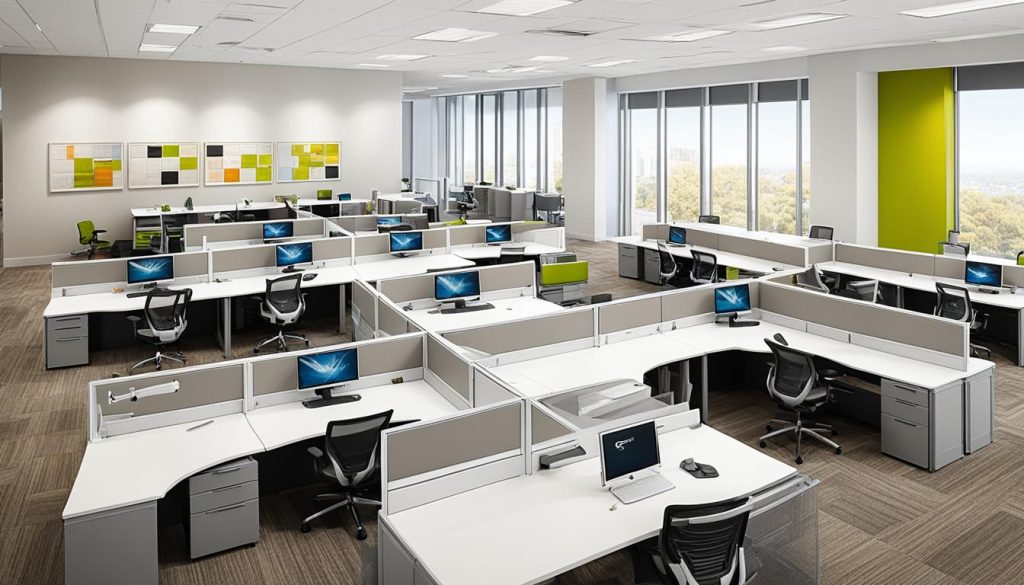
Do you find it hard to sit still while working? You’re not alone. A 2021 survey showed that about 12% of college students had ADHD. For those who need constant movement, flexible workstations are a game-changer.
Creating an adaptable workspace is key. Start with a height-adjustable desk. These desks let you switch between sitting and standing all day. Add an ergonomic chair that supports different postures too.
Think about a mobile office setup. Use furniture that’s light and easy to move. This could include:
- Foldable desks
- Rolling chairs
- Portable laptop stands
Add different seating options to your space. Try a balance ball chair or a standing desk converter. Remember, moving around is good for you. A 2015 study found that sitting too much increases the risk of dying by 24%.
“Ergonomic solutions empower employees to excel in their roles, impacting productivity positively.”
Don’t forget about accessories. 360-degree monitor mounts let you adjust your screen as you move. Having multiple power centers in your space means you’re always plugged in, wherever inspiration hits.
By making your workspace flexible, you’re not just meeting your need for movement. You’re also boosting your productivity and health. So, design a space that moves with you.
Agile Work Environments: Designing for Flexibility and Adaptability
Agile workplaces are changing how we design offices. They support different work styles and increase productivity. With reconfigurable furniture and multi-purpose areas, companies make spaces that change with needs.
Incorporating Reconfigurable Furniture
Reconfigurable furniture is key in agile workplaces. Modular desks, movable walls, and adjustable chairs let spaces change easily. This helps with different tasks and team sizes, keeping the office useful and lively.

Creating Multi-Purpose Areas
Multi-purpose areas are vital in agile workplaces. They can be meeting rooms, brainstorm spots, or quiet work areas. By having adaptable spaces, companies use space better and help teams work together.
Implementing Technology for Seamless Transitions
Technology is important in agile workspaces. Smart booking for desks and rooms, digital whiteboards, and team tools help with easy changes between tasks. This tech makes working together in person or remotely better.
“Agile workspaces contribute to increased job satisfaction and employee retention through flexibility and autonomy.”
Adopting agile workplace design has many benefits. Companies can save space, money, and boost employee happiness. By making spaces that fit individual needs, businesses create a more productive and connected team.
Collaborative Workspaces: Balancing Formal and Informal Meeting Areas
Creating a balanced collaborative workspace is key for today’s businesses. A study shows that 73% of business leaders want better spaces for working together and alone. To meet this need, mix formal and informal meeting areas in your office layout.
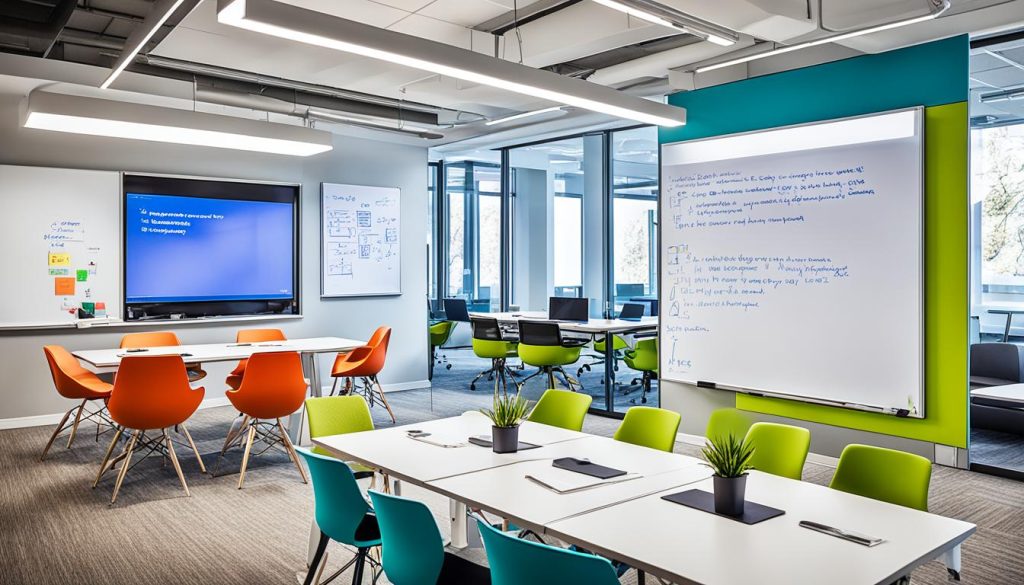
Informal meeting areas are crucial for spontaneous teamwork. They can have comfy seating like sofas or bean bags, making it easy for people to chat and brainstorm. These spaces help create a more open and creative work environment.
For serious meetings, you’ll need enclosed spaces with smart whiteboards and tools for video calls. These areas are great for focused meetings and presentations. Make sure to have spaces for different team sizes and meeting types.
Employees working in collaborative settings are 50% more productive than those working alone.
Finding the right balance between formal and informal areas is important. Only 27% of business owners say they have the perfect mix of collaboration and desk spaces. Here’s how to make your workspace better:
- Use modular furniture for flexible collaboration areas
- Create touchdown points for quick meetings
- Offer various settings to match different collaboration styles
By designing your collaborative workspace thoughtfully, you can increase productivity, employee happiness, and innovation in your company.
Focused Work Zones: Creating Quiet Areas for Deep Concentration
Creating quiet work areas is key for deep focus in your home office. With the right setup, you can increase productivity and lower stress. Let’s look at how to make a focused workspace that meets your needs.
Implementing Sound-Dampening Solutions
Sound-dampening solutions help reduce distractions. Use acoustic panels, rugs, or curtains to soak up noise. Noise-canceling headphones can also keep you focused in busy areas. Think about playing white noise or soft music to cover up unwanted sounds.
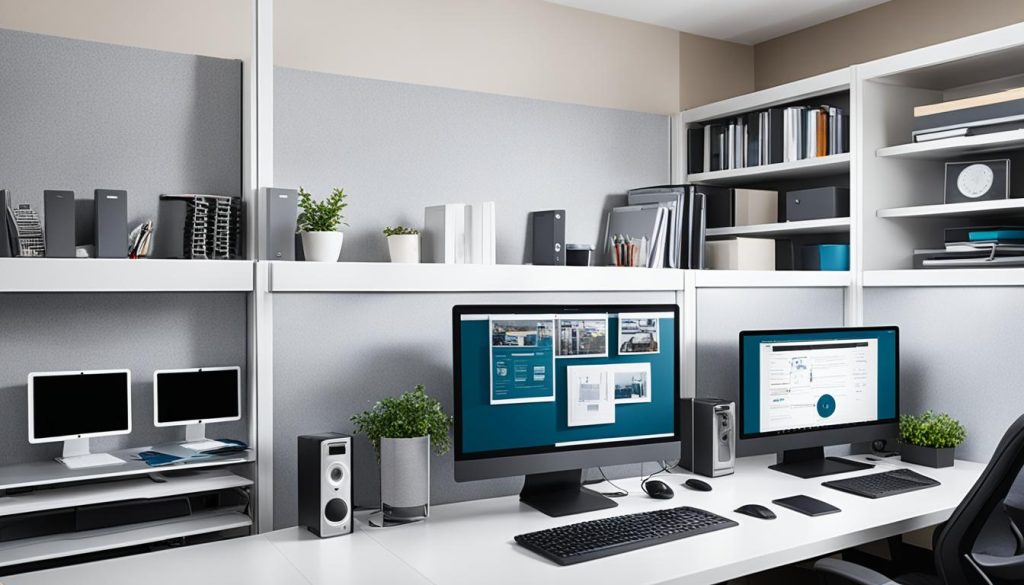
Designing Distraction-Free Corners
Make a special corner for deep work. Have your desk facing away from busy spots and use dividers if needed. Keep your area tidy and organized to stay focused. Adding plants can also improve air quality and make the space more calming.
Incorporating Ergonomic Furniture for Extended Focus Sessions
Invest in ergonomic office furniture for long focus periods. An adjustable chair and desk support good posture and cut down on tiredness. A standing desk offers flexibility in your work position. Don’t forget to take breaks every 45-90 minutes to stay sharp and focused.
“A well-designed quiet work area can boost productivity by up to 47% and improve overall job satisfaction.”
By using these tips, you can make a focused work zone that improves concentration and productivity in your home office. Customize these solutions to fit your specific needs and work style for the best outcomes.
Maximizing Small Spaces: Home Office Solutions for Limited Square Footage
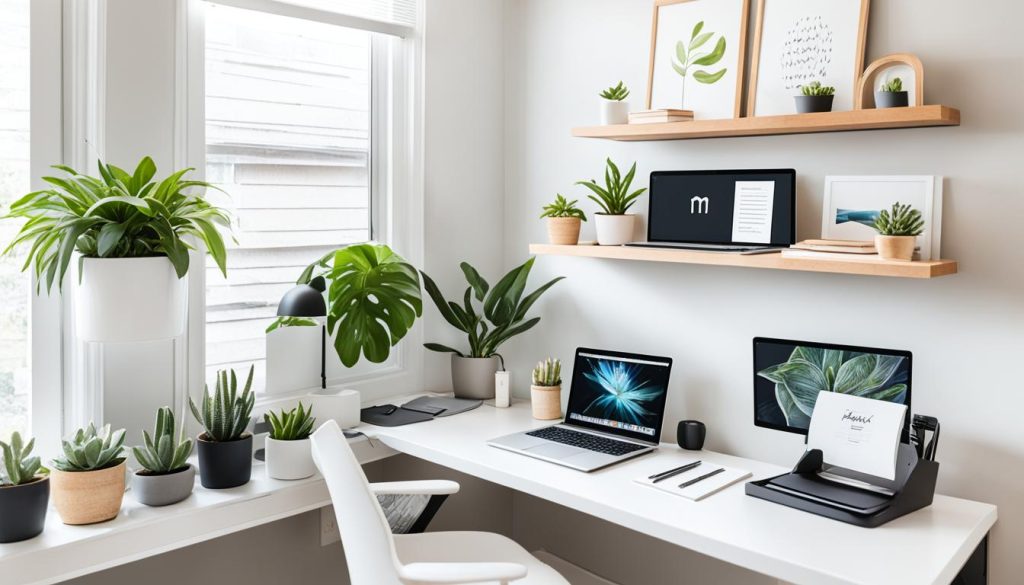
Creating a small home office can be tough, but smart planning can turn any small spot into a great workspace. Let’s look at some ways to make the most of limited space.
Wall-mounted desks are great for small areas. They help save floor space and are used by only 16% of small offices. Combine them with floating shelves for a neat storage system that keeps things close but doesn’t clutter your desk.
Multi-functional furniture is essential for a small office. Think about a desk that also serves as a vanity or a daybed that turns into extra seating. This approach, used by 12% of designs, makes the most of every inch of space.
Color is important in small offices. A bright palette, seen in 23% of designs, uses white, black, and millennial pink. These colors can make your space look bigger and more welcoming. Adding a big plant, found in 15% of setups, brings life and freshness to your office.
Don’t ignore hidden spots. 25% of designs turn a walk-in closet into a home office. This “cloffice” idea is a smart way to create a work area in tight spaces.
- Use vertical storage solutions to maximize capacity
- Opt for compact desks with built-in storage
- Choose transparent furniture to create an airy feel
With careful design and the right furniture, even tiny spaces can become inspiring and functional home offices.
Technology Integration: Enhancing Productivity Across Work Styles

Smart office solutions are changing the way we work. The market for smart offices was worth $39.7 billion in 2022 and is expected to hit $83.2 billion by 2028. This shows how much people want better work setups.
Office technology integration makes workspaces more efficient. Smart desks, IoT devices, and ergonomic furniture make work more comfortable and productive. Companies see a 20% increase in employee output with these technologies.
Intelligent climate and lighting controls adjust automatically with sensors. This makes your workspace more comfortable and helps save energy. Using color in smart office design also boosts morale and sparks creativity.
- Video conferencing tools improve collaboration
- Virtual whiteboards enhance innovation
- Cloud-based platforms support flexible work styles
Security is a big deal in smart offices. Systems like security cameras and motion sensors keep an eye on things in real-time. They also make sure remote work is secure, keeping your data safe from unauthorized access.
Automation in smart offices cuts down on boring tasks. You can focus on important work. Systems like scheduling for conference rooms and monitoring energy use make your day easier. This leads to a more efficient, comfortable, and productive work environment that fits your work style.
Personalizing Your Home Office: Adding Comfort and Inspiration
Your home office is more than just a place to work. It shows off your style and professional side. By choosing the right decor, you can make it a space that helps you work better and sparks creativity.
Incorporating Personal Touches and Decor
Add things that make your office your own. Show off your favorite art, family photos, or quotes that inspire you. These items make your space look great and keep you motivated when you’re working long hours. Research shows that 65% of workers do better in a space that feels personal.
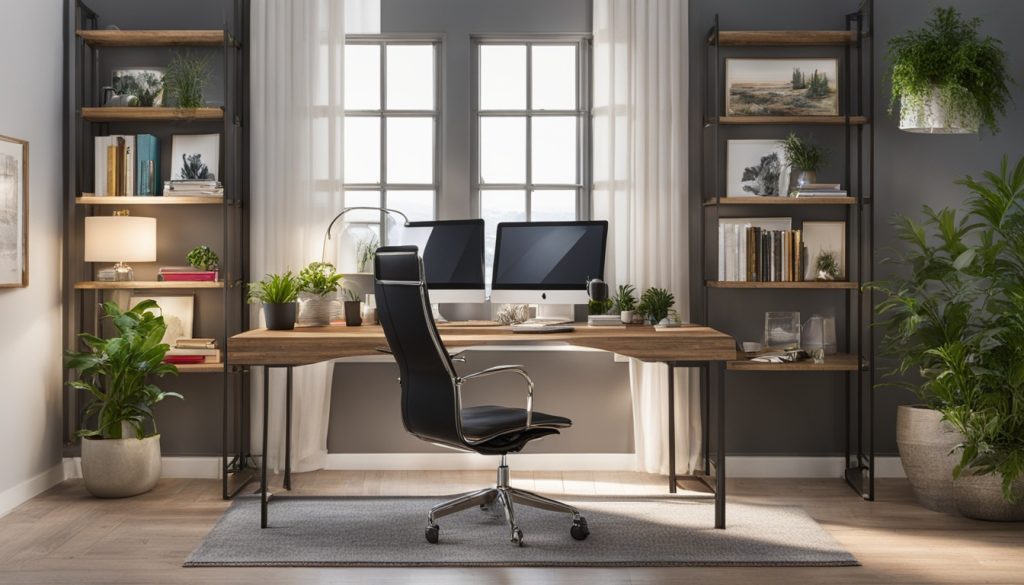
Optimizing Natural Light and Views
Good lighting is key for feeling good and staying productive. Place your desk near a window to get sunlight and views. If sunlight is hard to get, try full-spectrum light bulbs that act like natural light. This can help reduce eye strain and keep you energized all day.
Creating a Space That Reflects Your Professional Identity
Your home office should match your career goals and how you like to work. If you’re creative, go for a colorful, fun space. If you work in finance, a clean, simple look might be better. Make sure your office is set up to support your daily tasks and work flow.
“Your workspace is a canvas. Paint it with elements that inspire and motivate you every day.”
A well-designed home office is more than just pretty. It’s about making a place where you can do your best work and feel at home. With careful thought, you’ll be excited to start work in your unique space every day.
Conclusion
Creating a productive home office design is crucial for boosting efficiency and comfort. It’s about making a space that fits your work style. Whether you like dynamic environments or need structure, your office should match your needs.
Work style optimization is more than just looks. It’s about making a space that changes with you. With flexible furniture and tech, your office can grow with your needs. A well-designed workspace can really boost your productivity and happiness at work.
When setting up your home office, think about mixing collaboration and focus areas. Even in a small space, you can make different zones for different tasks. By making your space personal and adding things that inspire you, you’ll create a home office that feels just right for you. Investing in your workspace is investing in your success.

